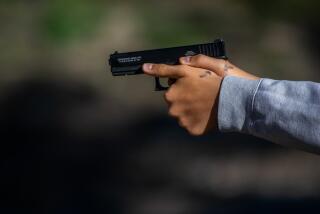Manufacturers Must Act to Cut Gun Deaths
- Share via
This has been a lousy year for gun makers. In seven incidents, rampages of kids shooting kids have seared names like Jonesboro, Ark., into our minds. A TV movie about U.S. Rep. Carolyn McCarthy--whose candidacy was rooted in the Long Island Railroad shooting of her husband and son--riveted national attention on gun violence. This spring’s “silent march” brought angry protesters to a half-dozen big gun companies from Massachusetts to Virginia as well as in San Francisco and Los Angeles. On May 30, a demonstration was held in front of Bryco Arms, a gun manufacturing firm in Costa Mesa.
The gun industry is being blamed for the deaths of nearly 50,000 children and teens in a single decade. Or at least for not doing much to prevent such tragedies.
Yet there is plenty that a responsible industry could--and should--do to save lives. An informal survey of experts in gun violence prevention has elicited dozens of suggestions.
Gun makers could set up authorized dealerships so guns sold to the black market could be traced and disreputable dealers identified by law enforcement officials. They could make firearms with indicators that show when they are loaded, like a toaster indicates when it is on.
Trigger locks could be installed so gun owners don’t have a choice about using them, like car air bags in contrast to seat belts. Gun makers could back federal regulation of secondary sales, so guns don’t slip into the wrong hands at gun shows, flea markets and other unregulated outlets.
And they could discontinue design elements made with criminals in mind, such as fingerprint-resistant finishes. Yet gun makers resist suggestions for changing the way they design, market and distribute their lethal products--because they don’t want to be held liable.
Californians hear a great deal about the Los Angeles area “junk gun” companies, manufacturers of low-cost, low-quality guns commonly used in street crimes. Junk guns are a problem--and about 70% of the nation’s junk guns are mass-produced right here in Southern California. But the lack of accountability is industrywide, extending cross-country to those Yankee companies with century-old names such as Colt, and Smith & Wesson.
Last October, industry executives announced that they would ship trigger locks with new guns. This, along the NRA’s misguided “Eddie Eagle” in-school program, is supposed to pacify critics. But Eddie Eagle is the proverbial fox of a marketing effort disguised in the lamb’s wool of a school-based program. And distributing trigger locks may save some lives, but it also neatly shifts liability to the consumer. Trigger lock programs are a drop in the bucket compared to what gun makers could do were they concerned about saving lives.
Like tobacco, what’s at stake here is nothing less than life itself. With over 30,000 people killed annually by guns in the United States, we are all victimized, directly or indirectly.
In 1995 and 1996, the leading cause of death of Orange County residents 15 to 24 years old was not drugs, disease or automobile accidents, but gunshot wounds. The statistics have faces and names.
Let’s not forget the five people killed the week before Christmas at the Caltrans yard in Orange by a shooter armed with five 30-round magazines. Or the 12-year-old Mission Viejo girl accidentally shot by her best friend after finding a loaded handgun in a briefcase. Or the La Palma boy who found the family’s “hidden” small-caliber handgun and, while wrestling with a buddy, was killed by a shot to the head. In 1995 we also had 125 suicides and hospitalized 479 people with firearm injuries, including 90 unintentional gunshot injuries.
That is why it is necessary for an organization such as Orange County Citizens for the Prevention of Gun Violence--replete with exhibits, fact sheets and knowledgeable speakers--to educate the community and decision-makers.
And that is also why, in the absence of strong federal controls, it is only decent that the industry shoulder more responsibility for preventing gun death. Handgun makers must be made to answer to the public concern about the economic, health and emotional costs of gun violence. Until they do, a few gun makers will continue to profit--while the rest of us pay a terrible price.
More to Read
Inside the business of entertainment
The Wide Shot brings you news, analysis and insights on everything from streaming wars to production — and what it all means for the future.
You may occasionally receive promotional content from the Los Angeles Times.









